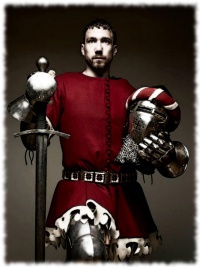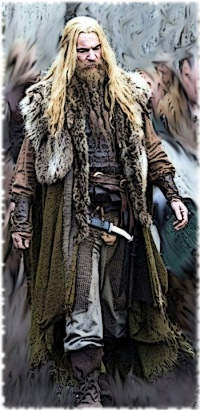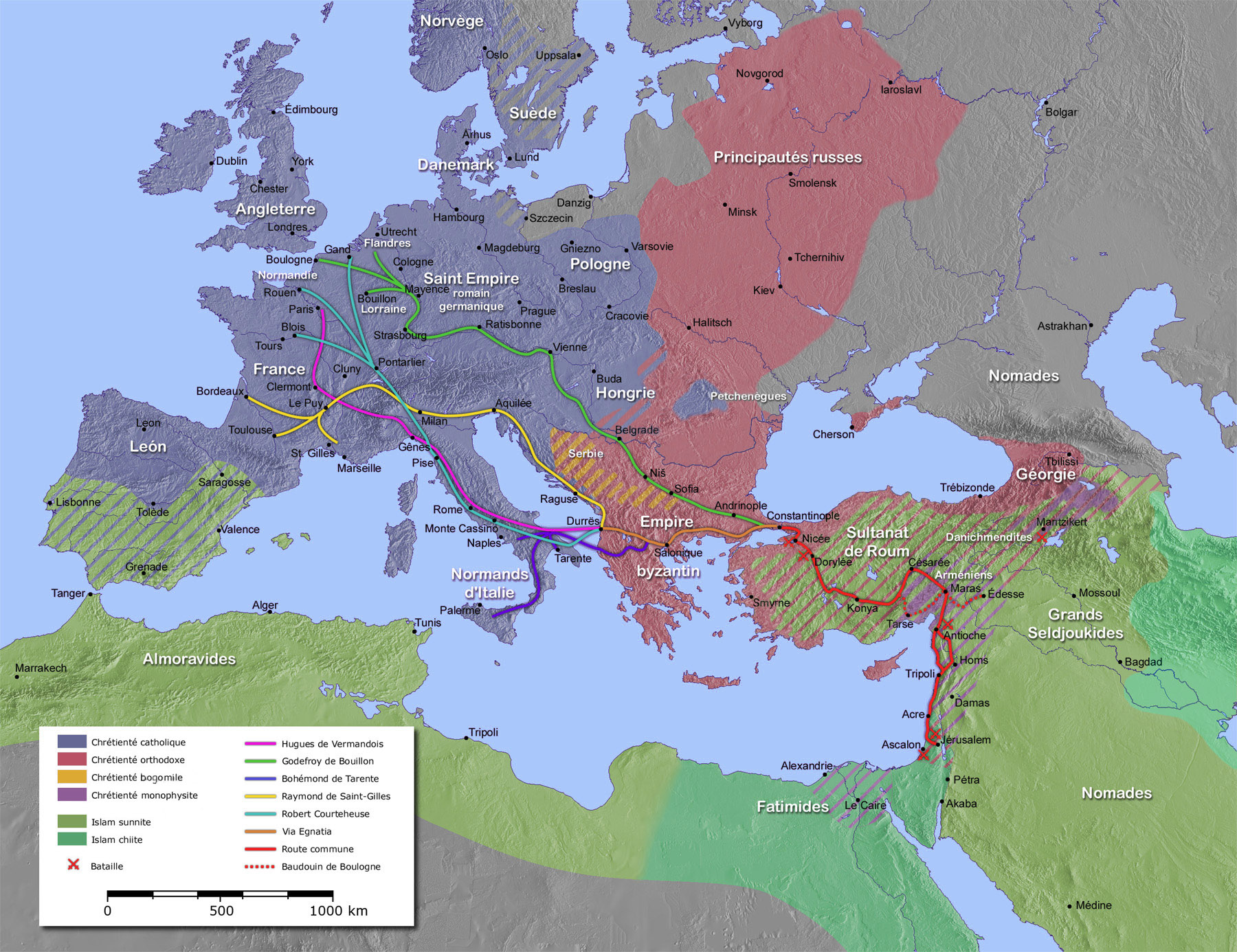Crusade of Ashes and Blood: Difference between revisions
| (74 intermediate revisions by 2 users not shown) | |||
| Line 1: | Line 1: | ||
;[[World of Darkness -- Medieval]] | ;[[World of Darkness -- Medieval]] - [[Bolverks Army]] - [[Boulogne-sur-Mer]] - [[Mainz]] - [[Strasbourg -- medieval]] - [[Regensburg]] - [[Vienna -- medieval]] - [[Belograd]] - [[Niš]] - [[Sofia]] - [[Andrinople]] - [[Constantinople -- medieval]] | ||
[[File:Map of the First Crusade in French.jpg]] | [[File:Map of the First Crusade in French.jpg]] | ||
<br> | <br> | ||
| Line 28: | Line 28: | ||
== '''The Mortal Crusade of Blood''' == | == '''The Mortal Crusade of Blood''' == | ||
=== '' | === ''The Poor Army of Christ'' === | ||
The great French nobles and their trained armies of knights, however, were not the first to undertake the journey towards Jerusalem. Urban had planned the departure of the first crusade for 15 August 1096, the Feast of the Assumption, but months before this, a number of unexpected armies of peasants and petty nobles set off for Jerusalem on their own, led by a charismatic priest called Peter the Hermit. Peter was the most successful of the preachers of Urban's message, and developed an almost hysterical enthusiasm among his followers, although he was probably not an "official" preacher sanctioned by Urban at Clermont. | The great French nobles and their trained armies of knights, however, were not the first to undertake the journey towards Jerusalem. Urban had planned the departure of the first crusade for 15 August 1096, the Feast of the Assumption, but months before this, a number of unexpected armies of peasants and petty nobles set off for Jerusalem on their own, led by a charismatic priest called Peter the Hermit. Peter was the most successful of the preachers of Urban's message, and developed an almost hysterical enthusiasm among his followers, although he was probably not an "official" preacher sanctioned by Urban at Clermont. | ||
| Line 36: | Line 36: | ||
:* [[Peter of Amiens]] -- ''Leader of the People's Crusade'' | :* [[Peter of Amiens]] -- ''Leader of the People's Crusade'' | ||
:* [[Walter Sans Avoir]] -- He was the lord of Boissy-sans-Avoir in the Île-de-France and lieutenant to Peter the Hermit. | :* [[Walter Sans Avoir]] -- He was the lord of Boissy-sans-Avoir in the Île-de-France and lieutenant to Peter the Hermit. | ||
:** [[Emicho of Flonheim]] -- Count of Flonheim | :** [[Emicho of Flonheim]] -- Count of Flonheim | ||
::** [[Grimhilt of Flonheim]] -- Younger sister of Count Emicho | |||
::** [[Hagen of Tronege]] -- Knight of Flonheim | |||
:** [[William the Carpenter]] -- Viscount of Melun | |||
:** [[Drogo of Nesle]] -- | |||
:** [[Lothar Aquilo]] -- | |||
:** [[Folkmar]] -- Saxon Priest and the only member of the Catholic priesthood to endorse attacks on Jews. | |||
:** [[Gottschalk]] -- A monk and popular preacher from Lorraine who led paupers on crusade throughout the Rhineland and into Hungary. | |||
:** [[Rosalie of Cambrai]] -- Nun who works the camp | |||
:** [[Clarembald of Vendeuil]] & [[Thomas, Lord of Coucy]] -- Frankish nobles who after having taken Jewish money, lent at interest, to go on Crusade and chose to repay their debts with steel and fire. | |||
---- | ---- | ||
<br> | <br> | ||
<br> | <br> | ||
---- | ---- | ||
=== '''Crusade of Princes''' === | === '''Crusade of Princes''' === | ||
The four main crusader armies left Europe around the appointed time in August 1096. They took different paths to Constantinople and gathered outside its city walls between November 1096 and April 1097; Hugh of Vermandois arrived first, followed by Godfrey, Raymond, and Bohemond. This time, Emperor Alexios was more prepared for the crusaders; there were fewer incidents of violence along the way.[ | The four main crusader armies left Europe around the appointed time in August 1096. They took different paths to Constantinople and gathered outside its city walls between November 1096 and April 1097; Hugh of Vermandois arrived first, followed by Godfrey, Raymond, and Bohemond. This time, Emperor Alexios was more prepared for the crusaders; there were fewer incidents of violence along the way.[ | ||
| Line 51: | Line 62: | ||
==== Northern French and Flanders Contingent ==== | ==== Northern French and Flanders Contingent ==== | ||
:* [[Godfrey of Bouillon]] -- | |||
:* [[Baldwin of Boulogne]] -- | ===== House of Bouillon ===== | ||
:* [[Godfrey of Bouillon]] -- Duke of Lower Lorraine and the future ruler of Jerusalem | |||
:* [[Baldwin of Boulogne]] -- Younger brother of Godfrey, Duke of Lower Lorraine and in the future, the first Latin King of Jerusalem | |||
:* [[Eustace III, Count of Boulogne]] -- Elder brother of both Godfrey and Baldwin, he was the heir designate to the County of Boulogne | |||
===== Other Crusaders ===== | |||
:* [[Hugh I of Vermandois]] -- | :* [[Hugh I of Vermandois]] -- | ||
::* -- [[Company of Three Crosses]] -- Those members of the Army of Bolverk who were the 3rd Company. | |||
:* [[Stephen II of Blois]] -- | :* [[Stephen II of Blois]] -- | ||
:* [[Robert II of Flanders]] -- | :* [[Robert II of Flanders]] -- | ||
:* [[Robert II of Normandy]] -- | :* [[Robert II of Normandy]] -- | ||
==== Norman-Italian Contingent ==== | ==== Norman-Italian Contingent ==== | ||
| Line 74: | Line 91: | ||
== <span style="color:#800000;"> '''The Cainite Crusade of Ashes''' == | == <span style="color:#800000;"> '''The Cainite Crusade of Ashes''' == | ||
<span style="color:#800000;">''The Crusade of Ashes is a Hodge-Podge collection of vampiric lords and commoners. It is roughly arranged in three ways: nationality, high clan versus low clan, and by political alliances. This ever shifting kaleidoscope of allegiances means that those who begin the crusade in one faction may find themselves breaking old compacts and pledging themselves to new associates as their interests change according to the vicissitudes of war. The following arrangement of ashen crusaders is how the crusade begins, but not necessarily how it will look as it progresses or how it will end.'' | |||
=== <span style="color:#800000;"> '''Crucesignatis''' (''Ashen Crusaders'') === | |||
==== <span style="color:#800000;"> '''Leaders of the Crusade''' ==== | |||
:* [[File:Ventrue Geoffri du Temple.jpg|200px]] -- '''[[Geoffri du Temple]]''' -- ''Childe of Alexander of Paris'' {Temporal Leader of the Ashen Crusade} [French] | |||
:* [[File:Lasombra Ecliastus.jpg|200px]] - '''[[Ecliastus]]''' -- ''Childe of Montano and Knight of Christ'' {Spiritual Leader of the Ashen Crusade} [French] | |||
=== <span style="color:#800000;"> ''' | ==== <span style="color:#800000;"> '''English Crusaders''' ==== | ||
:* [[File:Toreador Eadweard of Normandy.jpg|200px]] - '''[[Eadweard of Normandy]]''' -- ''Childe of Paris of Rome and Minstrel of London'' | |||
:* [[File:Ventrue Godwine of Caerhurst Duke of Amber.jpg|200px]] - '''[[Godwine of Caerhurst]]''' -- ''Childe of Mithras and Duke of Amber'' | |||
:* [[File:Ventrue Gethwine of Langworth Duchess of Amber.jpg|200px]] - '''[[Gethwine of Langworth]]''' -- ''Childe of Mithras and Duchess of Amber'' | |||
:* [[File:Cappadocian María Asunción.jpg|200px]] - '''[[María Asunción]]''' -- ''Handmaiden to the Gethwine, Duchess of Amber and Chronicler of the Crusade'' | |||
<br> | |||
<br> | |||
==== <span style="color:#800000;"> '''French Crusaders''' ==== | |||
:* [[File:Ventrue Geoffri du Temple.jpg|200px]] -- '''[[Geoffri du Temple]]''' -- ''Childe of Alexander of Paris'' | |||
:* [[File:Lasombra Ecliastus.jpg|200px]] - '''[[Ecliastus]]''' -- ''Childe of Montano and Knight of Christ'' | |||
:* [[File:Toreador Tristan de Montruse.jpg|200px]] -- '''[[Tristan de Montruse]]''' -- ''Knight of Roses'' | |||
:* '''[[Etienne de Poitiers]]''' -- Youngest Knight and childer of Nicholas the Younger. | :* '''[[Etienne de Poitiers]]''' -- Youngest Knight and childer of Nicholas the Younger. | ||
:* '''[[Saint Regis]]''' -- A Toreador monk who seeks to purify his soul. | |||
:* '''[[Eudes de Troyes]]''' -- Brujah guardian of the Champaign Fairs and traveling Promethean. | :* '''[[Eudes de Troyes]]''' -- Brujah guardian of the Champaign Fairs and traveling Promethean. | ||
:* '''[[Portia d’Orléans]]''' -- A Brujah lady of influence. | :* '''[[Portia d’Orléans]]''' -- A Brujah lady of influence. | ||
:* '''[[ | :* '''[[]]''' -- | ||
<br> | |||
<br> | |||
==== <span style="color:#800000;"> '''German Crusaders''' ==== | |||
:* [[File:Ventrue Bolverk in the Underworld.jpg|200px]] '''[[Bolverk]]''' -- ''Childe of Erik Eigermann'' | |||
:* '''[[]]''' -- | |||
:* '''[[]]''' -- | |||
:* '''[[]]''' -- | |||
:* '''[[]]''' -- | :* '''[[]]''' -- | ||
:* '''[[]]''' -- | :* '''[[]]''' -- | ||
<br> | |||
<br> | |||
==== <span style="color:#800000;"> '''Spanish Crusaders''' ==== | |||
:* '''[[]]''' -- | :* '''[[]]''' -- | ||
:* '''[[]]''' -- | :* '''[[]]''' -- | ||
| Line 91: | Line 136: | ||
<br> | <br> | ||
---- | ---- | ||
=== <span style="color:#800000;"> Crusader Missives === | === <span style="color:#800000;"> Crusader Missives === | ||
:[[Erik the Red to his childe Bolverk the Warlord]] - April 10th, 1096 A.D. {Paris} | :[[Erik the Red to his childe Bolverk the Warlord]] - April 10th, 1096 A.D. {Paris} | ||
| Line 102: | Line 148: | ||
:<span style="color:#800000;"> [[Murder Most Foul in Paris]] -- Opening story of Peregrinus et Sanguis in Cinere (April, 1096) [Story 1 / Part 1] | :<span style="color:#800000;"> [[Murder Most Foul in Paris]] -- Opening story of Peregrinus et Sanguis in Cinere (April, 1096) [Story 1 / Part 1] | ||
::<span style="color:#800000;"> [[Parisian Aftermath]] -- The conclusion to events that began in ''Murder Most Foul in Paris''. [Story 1 / Part 2] | ::<span style="color:#800000;"> [[Parisian Aftermath]] -- The conclusion to events that began in ''Murder Most Foul in Paris''. [Story 1 / Part 2] | ||
::<span style="color:#800000;"> [[Paris - What's Past is Prologue]] -- The coterie having gone their separate ways, return to Paris aid Lady Mortis.[Story 1 / Part 3] | ::<span style="color:#800000;"> [[Paris - What's Past is Prologue]] -- The coterie having gone their separate ways, return to Paris aid Lady Mortis.[Story 1 / Part 3] | ||
:<span style="color:#800000;"> [[Taking the Ashen Cross]] -- '''Story 4''' centers around the Crusade as it hits the road. (Mid May, 1096) | |||
::<span style="color:#800000;"> [[Mainz stands for Mogun]] -- Story 5: The Crusade arrives in the Rhineland in time for the Massacres. | |||
: [[Die Erste Losung]] | |||
---- | ---- | ||
<br> | <br> | ||
| Line 110: | Line 160: | ||
=== Sources === | === Sources === | ||
https://en.wikipedia.org/wiki/List_of_principal_leaders_of_the_Crusades | |||
https://en.wikipedia.org/wiki/First_Crusade | https://en.wikipedia.org/wiki/First_Crusade | ||
| Line 121: | Line 173: | ||
https://www.dhi.ac.uk/crusaders/ ('''Whose who of the Crusades - First & Second''') | https://www.dhi.ac.uk/crusaders/ ('''Whose who of the Crusades - First & Second''') | ||
http://themedievalworld.blogspot.com/2010/05/goose-who-led-crusade-well-sort-of.html | |||
---- | ---- | ||
<br> | <br> | ||
<br> | <br> | ||
---- | ---- | ||
Latest revision as of 14:31, 30 September 2023
- World of Darkness -- Medieval - Bolverks Army - Boulogne-sur-Mer - Mainz - Strasbourg -- medieval - Regensburg - Vienna -- medieval - Belograd - Niš - Sofia - Andrinople - Constantinople -- medieval
Introduction
The Pope Urbane II declared the need for a Crusade November of 1095.
Medieval Military Ranks
Medieval militaries did not have a unified rank structure; while the feudal lords were in some ways equivalent to modern officers, they didn't have a strict hierarchy—a king was conceived of as first among equals, not a monarch as later or ancient societies understood the concept, and all nobles were theoretically equals (hence "peers"). A nobleman was obligated to bring a set number of troops when asked by his liege-lord, a king or merely a higher-ranked noble who had obtained his service by the gift of land. The troops' lord retained at least nominal control over them—many medieval military planning sessions involved negotiating each lord's role in the coming battle—and each lord was allowed to leave after a predetermined amount of time had passed.
High Command in Medieval Armies
The command structure of armies was generally loose and varied considerably. Typically, the king and high-ranking lords would call out for all lords to gather their troops for a campaign. They would appoint a renowned noble to organize the assembling forces, the marshal. The term Field Marshal came from the marshal then leading the army on the march, and being in charge of organizing camps and logistics. Tactics for an upcoming battle were often decided by councils of war among the nobles leading the largest forces. Outside of campaigns, the High Constable had authority over the local constables, and commanders of the garrisons of major castles. The High Constable might have authority in the army due to his role of head of the regular cavalry.
Origins of Modern Ranks
As the Middle Ages came to an end, the rank structure of medieval armies became more formalized. The top officers were known as commissioned officers because their rank came from a royal commission. Army commissions were usually reserved for those of high stature—the aristocracy of mainland Europe and the aristocracy and gentry of Great Britain.
The basic unit of the medieval army was the company, a band of soldiers assigned (or raised) by a vassal lord on behalf of his lord (in later times the king himself). The vassal lord in command of the company was a commissioned officer with the rank of captain. Captain was derived from the Late Latin word capitaneus (meaning "head man" or chief).
The commissioned officer assisting the captain with command of the company was the lieutenant. Lieutenant was derived from the French language; the lieu meaning "place" as in a position; and tenant meaning "holding" as in "holding a position"; thus a "lieutenant" is somebody who holds a position in the absence of his superior. When he was not assisting the captain, the lieutenant commanded a unit called a platoon, particularly a more specialized platoon. The word is derived from the 17th-century French peloton, meaning a small ball or small detachment of men, which came from pelote, a ball.
The commissioned officer carrying the (infantry) company's flag was the ensign. The word ensign was derived from the Latin word insignia. In cavalry companies the equivalent rank was cornet. In English usage, these ranks were merged into the single rank of second lieutenant in the 19th Century.
Not all officers received a commission from the king. Certain specialists were granted a warrant, certifying their expertise as craftsmen. These warrant officers assisted the commissioned officers but ranked above the non-commissioned officers. They received their authority from superior officers rather than the king. The first NCOs were the armed servants (men-at-arms) of the aristocracy, assigned to command, organize and train the militia units raised for battle. After years of commanding a squad, an NCO could be promoted to sergeant, the highest NCO rank. While a sergeant might have commanded a squad upon promotion, he usually became a staff officer. While commissioned staff officers assisted their commander with personnel, intelligence, operations and logistics, the sergeant was a jack of all trades, concerning himself with all aspects of administration to maintain the enlisted men serving under his commander. Over time, sergeants were differentiated into many ranks as various levels of sergeants were used by the commanders of various levels of units.
A corporal commanded a squad. Squad derived from the Italian word for a "square" or "block" of soldiers. In fact, corporal was derived from the Italian caporal de squadra (head of the squad). Corporals were assisted by lancepesades. Lancepesades were veteran soldiers; lancepesade was derived from the Italian "lancia spezzata" meaning broken spear—the broken spear being a metaphor for combat experience, where such an occurrence was likely. The first lancepesades were simply experienced privates; who either assisted their corporal or performed the duties of a corporal themselves. It was this second function that made armies increasingly regard their lancepesades as a grade of corporal rather than a grade of private. As a result, the rank of lance corporal was derived from combining lancepesade and corporal.
As the Middle Ages came to an end, kings increasingly relied on professional soldiers to fill the bottom ranks of their armies instead of militiamen. Each of these professionals began their careers as a private. The private was a man who signed a private contract with the company commander, offering his services in return for pay. The money was raised through taxation; those yeomen (smallholding peasants) who did not fulfill their annual 40-day militia service paid a tax that funded professional soldiers recruited from the yeomanry. This money was handed to the company commanders from the royal treasury, the company commanders using the money to recruit the troops.
The Mortal Crusade of Blood
The Poor Army of Christ
The great French nobles and their trained armies of knights, however, were not the first to undertake the journey towards Jerusalem. Urban had planned the departure of the first crusade for 15 August 1096, the Feast of the Assumption, but months before this, a number of unexpected armies of peasants and petty nobles set off for Jerusalem on their own, led by a charismatic priest called Peter the Hermit. Peter was the most successful of the preachers of Urban's message, and developed an almost hysterical enthusiasm among his followers, although he was probably not an "official" preacher sanctioned by Urban at Clermont.
The People's Crusade lasted roughly six months from April to October 1096. It is also known as the Peasants' Crusade, Paupers' Crusade or the Popular Crusade as it was not part of the official Catholic Church-organised expeditions that came later. Led primarily by Peter the Hermit with forces of Walter Sans Avoir, the army was destroyed by the Seljuk forces of Kilij Arslan at Civetot, northwestern Anatolia.
Leading Figures
- Peter of Amiens -- Leader of the People's Crusade
- Walter Sans Avoir -- He was the lord of Boissy-sans-Avoir in the Île-de-France and lieutenant to Peter the Hermit.
- Emicho of Flonheim -- Count of Flonheim
- Grimhilt of Flonheim -- Younger sister of Count Emicho
- Hagen of Tronege -- Knight of Flonheim
- William the Carpenter -- Viscount of Melun
- Drogo of Nesle --
- Lothar Aquilo --
- Folkmar -- Saxon Priest and the only member of the Catholic priesthood to endorse attacks on Jews.
- Gottschalk -- A monk and popular preacher from Lorraine who led paupers on crusade throughout the Rhineland and into Hungary.
- Rosalie of Cambrai -- Nun who works the camp
- Clarembald of Vendeuil & Thomas, Lord of Coucy -- Frankish nobles who after having taken Jewish money, lent at interest, to go on Crusade and chose to repay their debts with steel and fire.
Crusade of Princes
The four main crusader armies left Europe around the appointed time in August 1096. They took different paths to Constantinople and gathered outside its city walls between November 1096 and April 1097; Hugh of Vermandois arrived first, followed by Godfrey, Raymond, and Bohemond. This time, Emperor Alexios was more prepared for the crusaders; there were fewer incidents of violence along the way.[
Southern French Contingent
- Raymond IV, Count of Toulouse -- Pope Urban II's appointed steward of the crusade.
- Adhemar of Le Puy -- Pope Urban II's appointed spiritual leader of the crusade.
- Peter Bartholomew -- a soldier and mystic from France who was part of the First Crusade as part of the army of Raymond of Saint-Gilles.
Northern French and Flanders Contingent
House of Bouillon
- Godfrey of Bouillon -- Duke of Lower Lorraine and the future ruler of Jerusalem
- Baldwin of Boulogne -- Younger brother of Godfrey, Duke of Lower Lorraine and in the future, the first Latin King of Jerusalem
- Eustace III, Count of Boulogne -- Elder brother of both Godfrey and Baldwin, he was the heir designate to the County of Boulogne
Other Crusaders
-
- -- Company of Three Crosses -- Those members of the Army of Bolverk who were the 3rd Company.
Norman-Italian Contingent
Eastern Leaders
The Cainite Crusade of Ashes
The Crusade of Ashes is a Hodge-Podge collection of vampiric lords and commoners. It is roughly arranged in three ways: nationality, high clan versus low clan, and by political alliances. This ever shifting kaleidoscope of allegiances means that those who begin the crusade in one faction may find themselves breaking old compacts and pledging themselves to new associates as their interests change according to the vicissitudes of war. The following arrangement of ashen crusaders is how the crusade begins, but not necessarily how it will look as it progresses or how it will end.
Crucesignatis (Ashen Crusaders)
Leaders of the Crusade
 -- Geoffri du Temple -- Childe of Alexander of Paris {Temporal Leader of the Ashen Crusade} [French]
-- Geoffri du Temple -- Childe of Alexander of Paris {Temporal Leader of the Ashen Crusade} [French] - Ecliastus -- Childe of Montano and Knight of Christ {Spiritual Leader of the Ashen Crusade} [French]
- Ecliastus -- Childe of Montano and Knight of Christ {Spiritual Leader of the Ashen Crusade} [French]
English Crusaders
 - Eadweard of Normandy -- Childe of Paris of Rome and Minstrel of London
- Eadweard of Normandy -- Childe of Paris of Rome and Minstrel of London - Godwine of Caerhurst -- Childe of Mithras and Duke of Amber
- Godwine of Caerhurst -- Childe of Mithras and Duke of Amber - Gethwine of Langworth -- Childe of Mithras and Duchess of Amber
- Gethwine of Langworth -- Childe of Mithras and Duchess of Amber - María Asunción -- Handmaiden to the Gethwine, Duchess of Amber and Chronicler of the Crusade
- María Asunción -- Handmaiden to the Gethwine, Duchess of Amber and Chronicler of the Crusade
French Crusaders
 -- Geoffri du Temple -- Childe of Alexander of Paris
-- Geoffri du Temple -- Childe of Alexander of Paris - Ecliastus -- Childe of Montano and Knight of Christ
- Ecliastus -- Childe of Montano and Knight of Christ -- Tristan de Montruse -- Knight of Roses
-- Tristan de Montruse -- Knight of Roses- Etienne de Poitiers -- Youngest Knight and childer of Nicholas the Younger.
- Saint Regis -- A Toreador monk who seeks to purify his soul.
- Eudes de Troyes -- Brujah guardian of the Champaign Fairs and traveling Promethean.
- Portia d’Orléans -- A Brujah lady of influence.
- [[]] --
German Crusaders
 Bolverk -- Childe of Erik Eigermann
Bolverk -- Childe of Erik Eigermann- [[]] --
- [[]] --
- [[]] --
- [[]] --
- [[]] --
Spanish Crusaders
- [[]] --
- [[]] --
- [[]] --
- [[]] --
- [[]] --
Crusader Missives
- Erik the Red to his childe Bolverk the Warlord - April 10th, 1096 A.D. {Paris}
- Alexander - Sovereign of the Ile de France to Mercuzio Tiberus - Childe of Helena - April 10th, 1096 A.D. {Paris}
- Béatrix - Duchesse des Roses to Mercuzio Tiberus - Thief of Golgotha & Count of Corinth - April 10th, 1096 A.D. {Paris}
Quests of the Crusade
- Murder Most Foul in Paris -- Opening story of Peregrinus et Sanguis in Cinere (April, 1096) [Story 1 / Part 1]
- Parisian Aftermath -- The conclusion to events that began in Murder Most Foul in Paris. [Story 1 / Part 2]
- Paris - What's Past is Prologue -- The coterie having gone their separate ways, return to Paris aid Lady Mortis.[Story 1 / Part 3]
- Taking the Ashen Cross -- Story 4 centers around the Crusade as it hits the road. (Mid May, 1096)
- Mainz stands for Mogun -- Story 5: The Crusade arrives in the Rhineland in time for the Massacres.
Sources
https://en.wikipedia.org/wiki/List_of_principal_leaders_of_the_Crusades
https://en.wikipedia.org/wiki/First_Crusade
https://en.wikipedia.org/wiki/Christian_forces_of_the_First_Crusade
https://en.wikipedia.org/wiki/Medieval_warfare
https://en.wikipedia.org/wiki/Military_rank
https://en.wikipedia.org/wiki/Medieval_weights_and_measures
https://www.dhi.ac.uk/crusaders/ (Whose who of the Crusades - First & Second)
http://themedievalworld.blogspot.com/2010/05/goose-who-led-crusade-well-sort-of.html
